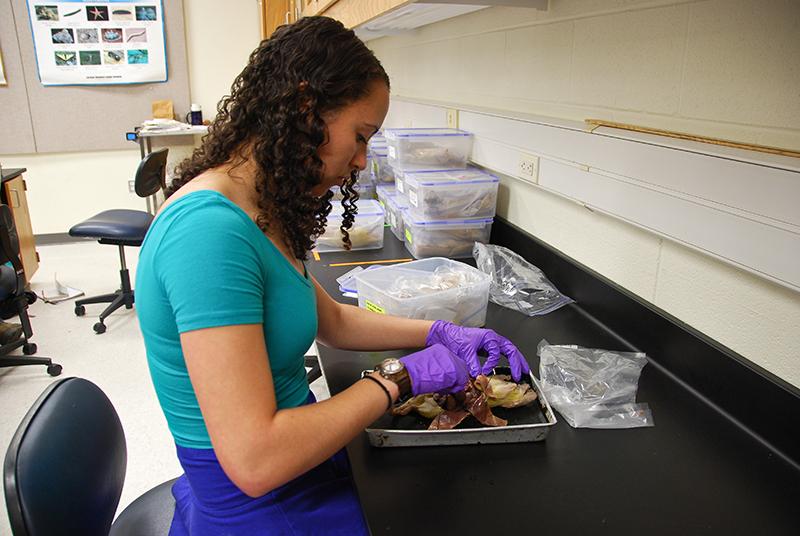Professors Discuss Pros, Cons of Dissection in Intro Labs
College first-year Caracol Haley dissects a rat for her Organismal Biology class. Instead of having students dissect rats, the instructor of one of the lab sections this semester has decided to challenge them to create their own organ.
April 17, 2015
Students in five lab sections of a 100-level biology class dissected rats last week, but those in the sixth section did not. Instead, the section, taught by Associate Professor Taylor Allen of the Biology department, presented ideas for fictional organs for the human body.
“The project seeks to deepen students’ understanding of body plans and physiological processes, as well as to develop skills related to creative problem solving, innovative thinking and scientific collaboration,” Allen said. “The main impulse is to do something creative. I’m an engineer, so that’s what’s fun for me. It’s just a blast to see what people come up with in terms of designs.”
This is the second year that the content in various introductory Biology labs has differed. Allen stated, however, that students who wanted to inform their organ design by dissecting rats or grasshoppers could do so and that, in fact, roughly half of his section did opt to dissect this semester.
“The idea is to make an environment comfortable for all, which is difficult if somebody is truly opposed to dissection. There’s a need to be tolerant and welcoming,” Allen said.
Allen also said that he had helped facilitate discussions between students in Ellen Wurtzel’s History of Science class and some of his biology students who have participated in dissections.
“We come together to try to think about who experiences this pain. Do animals experience pain? … We’ve had two lunchtime discussions on sensation in animals, trying to understand it from a philosophical, historical and biological vantage point.”
The disagreement within the Biology department shows how this topic continues to provoke conversation within the scientific community.
To Biology Professor Jane Bennett, who teaches most of the other lab sections, the rat dissections are an invaluable learning tool.
“Any kind of dissection — if you’re not doing the dissection but, let’s say, looking at a picture of it or a video of it — it’s the difference of looking at a sculpture versus actually being able to touch the sculpture,” Bennett said.
Bennett emphasized that the rats the Biology department uses arrive at Oberlin already dead and embalmed, as opposed to other science departments at Oberlin that use living rats for experiments. She also said that students in her sections were free to opt out of the dissection.
“We have no problem with students who don’t want to dissect,” Bennett said. “We’ve offered in the past [that] they can look on with somebody. I’ve got a number of students doing that. We offer them the ability to go online and look at anything they want. … They can learn the material any way they want. Personally, I think it gives them greater benefit to really be able to touch things, move around and look for stuff — things that are really not quite as amenable in a two-dimensional mode.”
While Bennett believes the rat dissection to be vital to the course, she said she respects her colleague’s decision.
“There’s great autonomy in teaching at Oberlin, so that is what he has decided to do with his students for that particular lab. As long as the department’s fine with it, I’m fine with it.”
Bennett also noted the popularity of the rat dissection lab with her students.
“If you read the evaluations of the lab work, it’s the most frequently mentioned favorite lab,” Bennett said. “It’s not that students don’t want to do it. And there are students who haven’t had that opportunity in the course [who have] been upset by the fact that they haven’t.”
College Sophomore Marcus Caceres, who took the class last spring, found the experience useful.
“I thought it was a really great learning experience, very hands-on. I don’t think anyone had a particularly hard time,” said Caceres. “I consider myself an animal person, but I think it’s pretty necessary to do these kinds of things.”
However, other community members believe that no dissections should take place at Oberlin at all.
“The use of dead animals in dissections is not as concerning as the use of live animals in painful procedures, which also happens at Oberlin,” said Ari Benjamin, a former member of Oberlin Animal Rights who graduated from the College in December, in an email to the Review. “But the dissections still require the unnecessary killing of healthy animals. They should be discontinued, since there are plenty of alternate ways of learning anatomy, such as diagrams or even virtual dissections.”
























